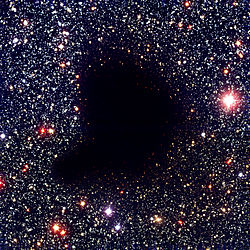Temná mlhovina
Temná mlhovina je mlhovina, která není blízko žádné hvězdy, která by ji emitovala k svícení (emisní mlhovina), nebo by se jen světlo hvězdy odráželo na částečkách prachu v mlhovině (reflexní mlhovina). Temné mlhoviny zpravidla pozorujeme jen díky tomu, že za nimi svítí další objekty, a pak ji vnímáme jako tmavou oblast.
Složením jsou stejné jako difuzní mlhoviny, to znamená vodík H2 (v molekulární formě), pak také helium a částečky prachu, ty velmi efektivně brání v průchodu viditelného světla.
Temné mlhoviny mohou být vzdálené až několik stovek světelných let a jejich hmotnost může být až desítky miliónů hmotností Slunce. To z nich dělá obrovskou zásobárnu materiálu pro vznik hvězd.
Ukázka dalších temných mlhovin:


Externí odkazy
 Obrázky, zvuky či videa k tématu temná mlhovina na Wikimedia Commons
Obrázky, zvuky či videa k tématu temná mlhovina na Wikimedia Commons
Média použitá na této stránce
Autor: ESO, Licence: CC BY 4.0
Image of the famous early-type spiral galaxy Messier 104, widely known as the "Sombrero" (the Mexican hat) because of its particular shape. The "Sombrero" is located in the constellation Virgo (The Virgin), at a distance of about 50 million light-years.
Autor: European Southern Observatory, Licence: CC BY 4.0
A reproduction of a composite colour image of the Horsehead Nebula and its immediate surroundings. It is based on three exposures in the visual part of the spectrum with the FORS2 multi-mode instrument at the 8.2-m KUEYEN telescope at Paranal. It was produced from three images, obtained on February 1, 2000, with the FORS2 multi-mode instrument at the 8.2-m KUEYEN Unit Telescope and extracted from the VLT Science Archive Facility . The frames were obtained in the B-band (600 sec exposure; wavelength 429 nm; FWHM 88 nm; here rendered as blue), V-band (300 sec; 554 nm; 112 nm; green) and R-band (120 sec; 655 nm; 165 nm; red). The original pixel size is 0.2 arcsec. The photo shows the full field recorded in all three colours, approximately 6.5 x 6.7 arcmin 2 . The seeing was about 0.75 arcsec. This image is available as a mounted image in the ESOshop. #L
Autor: ESO, Licence: CC BY 4.0
This image shows a colour composite of visible and near-infrared images of the dark cloud Barnard 68 . It was obtained with the 8.2-m VLT ANTU telescope and the multimode FORS1 instrument in March 1999. At these wavelengths, the small cloud is completely opaque because of the obscuring effect of dust particles in its interior.





